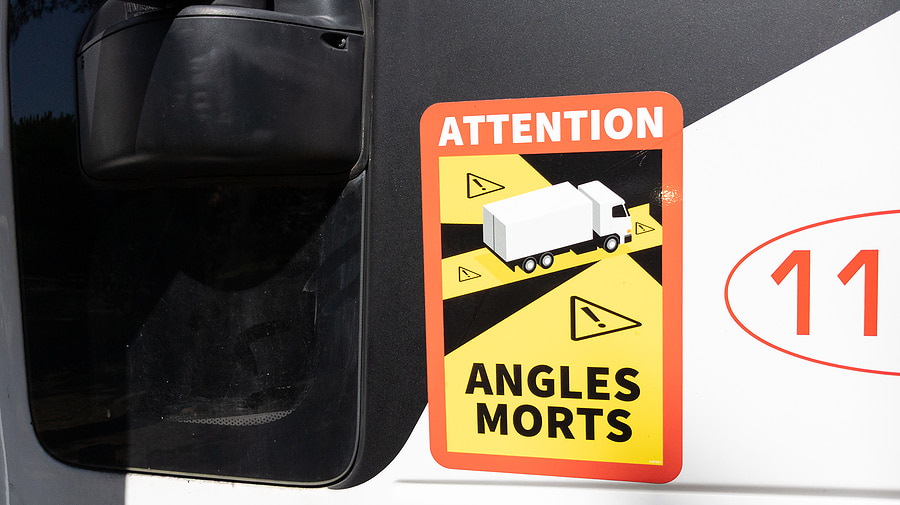Large trucks traverse California’s highways and interstates regularly. Most drivers get used to seeing those big trucks, especially if they take well-traveled main roads. However, many drivers fail to realize big trucks’ danger, especially for drivers in their blind spots they may meet with a truck accident in California.

What Are Truck Blind Spots?
Truck blind spots include the areas around the truck where the truck driver cannot see their surroundings due to the design of the vehicle and the limitations of its mirrors and windows. Big trucks usually have significantly larger blind spots than the average passenger vehicle.
Modern trucks may have some technological options, including cameras, to see more of what happens around them, reducing the risk of a dangerous collision. However, drivers should always assume that truck drivers cannot reasonably see them when they enter a common blind spot and take steps to get out of the blind spot as soon as possible.
Where Are Truck Blind Spots?
Large trucks have blind spots on all four sides, front, back, left, and right.
The Front of the Vehicle
Many trucks have an area directly in front of the vehicle where the driver cannot see. These blind spots pose a more significant danger to pedestrians, cyclists, and motorcycle riders than to the average passenger vehicle, which would remain visible. However, pedestrians or cyclists passing in front of a big truck should exercise care to ensure that the driver sees and acknowledges them and remains visible for as long as possible when moving through the blind spot area.
The Sides of the Vehicle
The truck’s right side has a more prominent blind spot than the left since the truck driver must rely on only mirrors to see down that side of the vehicle. However, trucks also have large blind spots down their left sides where the driver cannot see.
Drivers must exercise particular caution when sharing the road with a truck. If they must drive alongside a truck, moving out of the blind spot as quickly as possible can keep them safer on the road.
The Rear of the Vehicle
Big trucks do not have the same rearview mirror options that passenger vehicle drivers use. That may not pose a frequent hazard on the road since trucks usually only move forward. However, whenever a truck driver needs to put his vehicle in reverse, that blind spot to the vehicle’s rear can pose a substantial problem.
In parking lots, around loading docks, and even when the truck driver might need to adjust his position on the road, drivers behind should exercise considerable caution to ensure they do not inadvertently get hit.
Trucks’ rear blind spots can also prove problematic because of the size and position of their trailers: smaller passenger vehicles may be able to slide under the back of the trailer, resulting in substantial damage and injury for passengers in the vehicle.
Why Truck Drivers’ Blind Spots Present Such a Problem on the Road?
Truck drivers get used to their large blind spots and usually prove adept at avoiding collisions and keeping the truck safely on the road despite potential hazards. However, blind spots can pose a particular problem in several situations.
#1. Large blind spots can make changing lanes difficult.
Many truck drivers have a hard time changing lanes safely because they cannot see down the side of the vehicle. Truck drivers must maintain awareness of the flow of traffic around them and, in many cases, rely on the other drivers around them to help them change lanes safely.
An inattentive truck driver may fail to recognize the presence of a vehicle in his blind spot, especially if a driver hovers there for an extended period instead of moving through the truck driver’s blind spot promptly.
#2. Many passenger vehicle drivers ignore the truck’s blind spot when the truck driver needs to make a right turn.
Big truck drivers often choose to make wide right turns to get more visibility. However, passenger vehicle drivers may not allow adequate space for the truck driver to complete that turn safely, especially in large intersections. In some cases, passenger vehicle drivers may fail to note the truck’s turn signals or recognize its intention until the truck enters the intersection and it is too late to evade a collision.
#3. Big truck drivers who grow distracted may have a hard time tracking what happens around them.
Often, as truck drivers spend increasingly long hours on the road, they may have a hard time keeping their attention on driving. Unfortunately, truck drivers may need to compensate for those large blind spots by maintaining greater overall awareness of the position of other vehicles. Failing to maintain that awareness and growing distracted could increase the risk of an accident due to inadequate blind spot awareness.
#4. Truck drivers have a hard time figuring out what happens behind them.
When backing up is necessary around loading docks and parking lots, truck drivers may have difficulty with large blind spots because they cannot predict other drivers’ behavior or ensure their blind spots are clear. Truck drivers may not realize that a driver has moved up behind the vehicle resulting in a collision.
#5. Big truck blind spots can be hazardous to pedestrians and cyclists who are less visible.
While passenger vehicles can be challenging to track through big truck blind spots, many pedestrians and cyclists find themselves at more of a disadvantage. In many cases, truck drivers may have a much harder time tracking the presence of pedestrians and cyclists.
Pedestrians and cyclists move much more slowly than passenger vehicles, meaning they linger longer in a big truck’s blind spot. Furthermore, pedestrians and cyclists may have fewer options for notifying a truck driver of their presence and may not have the ability to respond quickly or avoid potential danger.
Sharing the Road Safely With Big Trucks: Staying out of Blind Spots
Simply recognizing the presence of big truck blind spots and doing your best to stay out of them can help you safely share the road with big trucks, buses, and other large vehicles.
However, to decrease the overall risk of a severe collision, you can also:
- Stay out of big trucks’ blind spots when possible. When driving beside a big truck or another large vehicle, do your best to avoid the truck’s blind spot. In some cases, traffic flow may allow you to speed up and get ahead of the truck. In other cases, you may need to decrease your speed until you fall further behind the truck. Even in tight traffic, staying out of a big truck’s blind spot can help you stay safe.
- When you must pass through a truck’s blind spot, do so quickly. You may need to pass through a big truck’s blind spot to pass the truck or change your position on the road. Try to complete the maneuver as quickly as possible. Do not linger in the truck driver’s blind spot if you can avoid it.
- Know when the truck driver can see you. A truck driver can see you if you see his face in his mirror. If you cannot see the truck driver’s face, he may not be able to acknowledge your presence, creating a risk that a collision will occur. Learning to identify a truck’s blind spots can help avoid the risk of lingering in that space, which can make everyone on the road safer.
- Leave plenty of room for big trucks to turn. Large trucks need more room to make a right turn than others. With a severe trucking industry shortage, many trucking companies have less-experienced drivers out on the road who need more room to maneuver. If you notice a driver signaling to make a turn, make sure he has adequate room to complete a wide turn with full visibility. Do not move up into the truck driver’s blind spots while turning to avoid raising your risk of an accident.
- Do not pass too close to the front of a truck as a pedestrian or cyclist. When the light changes or you have a traffic signal indicating that you can cross traffic, you can feel relatively confident that a truck will remain stationary. However, keep in mind that traffic signals may change before you can complete crossing the road. If the truck driver cannot see you, it may prove more difficult to avoid a collision. Put distance between yourself and the truck before crossing. Make eye contact with the truck driver to ensure they note your presence and will wait for you to finish crossing.
- Pay attention to truck drivers’ signals. If you do need to travel beside, behind, or near a truck, pay attention to the truck driver’s signals. A truck driver should indicate that they need to pass or change lanes. If you see them signaling while in a blind spot, notify the truck driver of your presence with your horn. If the truck driver does have adequate room to cross over in front of you, you can flash your headlights to let them know there is room to complete the maneuver.
- Never move behind a truck in reverse. If you notice a truck backing up, do not move behind it. Most trucks have large blind spots behind them, and the driver may have no way to see you and avoid a collision. Take an alternate route to avoid getting behind the truck while it backs up or if you do not know its direction.
- Pay particular attention to heavy equipment around construction sites or in parking lots. Trucks behave relatively predictably on the road, and you can tell where the truck will go based on traffic signals. In parking lots, loading docks, and dealing with heavy equipment on construction sites, it can prove much more difficult to establish where the truck driver intends to go. Keep your distance and make sure you know the truck driver’s intent before getting closer. When possible, make direct eye contact with the truck driver before moving into an area where the truck may travel.

What to Do After a Blind Spot Accident?
If you suffered injuries in a blind spot accident with a truck driver, an experienced truck accident attorney could help guide you through the insurance claim process. After reporting the accident and getting immediate medical care, talk to an attorney about your right to compensation for your injuries and losses. A lawyer can help prove the truck driver’s liability for your accident and ensure you receive what you deserve.









